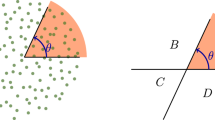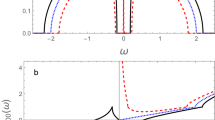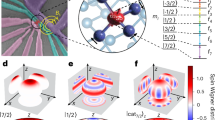Abstract
Topological defects, such as monopoles, vortex lines or domain walls, mark locations where disparate choices of a broken-symmetry vacuum elsewhere in the system lead to irreconcilable differences1,2. They are energetically costly (the energy density in their core reaches that of the prior symmetric vacuum) but topologically stable (the whole manifold would have to be rearranged to get rid of the defect). Here we show how, in a paradigmatic model of a quantum phase transition, a topological defect can be put in a non-local superposition, so that—in a region large compared with the size of its core—the order parameter of the system is ’undecided’ by being in a quantum superposition of conflicting choices of the broken symmetry. We dub such a topological Schrödinger-cat state a ‘Schrödinger kink’, and devise a version of a double-slit experiment suitable for topological defects to describe one possible manifestation of the phenomenon. Coherence detectable in such experiments will be suppressed as a consequence of interaction with the environment. We analyse the environment-induced decoherence and discuss its role in symmetry breaking.
This is a preview of subscription content, access via your institution
Access options
Subscribe to this journal
Receive 12 print issues and online access
$259.00 per year
only $21.58 per issue
Buy this article
- Purchase on SpringerLink
- Instant access to full article PDF
Prices may be subject to local taxes which are calculated during checkout




Similar content being viewed by others
References
Mermin, N. D. The topological theory of defects in ordered media. Rev. Mod. Phys. 51, 591–648 (1979).
Michel, L. Symmetry defects and broken symmetry. Configurations hidden symmetry. Rev. Mod. Phys. 52, 617–651 (1980).
Kibble, T. W. B. Topology of cosmic domains and strings. J. Phys. A 9, 1387–1398 (1976).
Kibble, T. W. B. Some implications of a cosmological phase transition. Phys. Rep. 67, 183–199 (1980).
Zurek, W. H. Cosmological experiments in superfluid helium? Nature 317, 505–508 (1985).
Zurek, W. H. Cosmic strings in laboratory superfluids and the topological remnants of other phase transitions. Acta Phys. Pol. B 24, 1301–1311 (1993).
Zurek, W. H. Cosmological experiments in condensed matter systems. Phys. Rep. 276, 177–221 (1996).
Kibble, T. Phase-transition dynamics in the lab and the universe. Phys. Today 60, 47–52 (September, 2007).
Anglin, J. R. & Zurek, W. H. Vortices in the wake of rapid Bose–Einstein condensation. Phys. Rev. Lett. 83, 1707–1710 (1999).
Zurek, W. H., Dorner, U. & Zoller, P. Dynamics of a quantum phase transition. Phys. Rev. Lett. 95, 105701 (2005).
Dziarmaga, J. Dynamics of a quantum phase transition: Exact solution of the quantum Ising model. Phys. Rev. Lett. 95, 245701 (2005).
Zurek, W. H. Decoherence and the transition from quantum to classical. Phys. Today 44, 36–44 (October, 1991).
Paz, J. P. & Zurek, W. H. in Environment-Induced Decoherence and the Transition from Quantum to Classical (eds Kaiser, R., Westbrook, C. & David, F.) Course 8, 533–614 (Les Houches Lectures Session LXXII: Coherent Atomic Matter Waves, Springer, 2001).
Zurek, W. H. Decoherence, einselection, and the quantum origins of the classical. Rev. Mod. Phys. 75, 715–775 (2003).
Joos, E. et al. Decoherence and the Appearance of a Classical World in Quantum Theory (Springer, 2003).
Schlosshauer, M. Decoherence and the Quantum-to-Classical Transition (Springer, 2008).
Nielsen, M. A. & Chuang, I. L. Quantum Computation and Quantum Information (Cambridge Univ. Press, 2000).
Zurek, W. H. Pointer basis of quantum apparatus: Into what mixture does the wave packet collapse? Phys. Rev. D 24, 1516–1525 (1981).
Zurek, W. H. Environment-induced superselection rules. Phys. Rev. D 26, 1862–1880 (1982).
Wheeler, J. A. & Zurek, W. H. Quantum Theory and Measurement (Princeton Univ. Press, 1983).
Friedenauer, A., Schmitz, H., Glueckert, J. T., Porras, D. & Schaetz, T. Simulating a quantum magnet with trapped ions. Nature Phys. 4, 757–761 (2008).
Kim, K. et al. Quantum simulation of frustrated Ising spins with trapped ions. Nature 465, 590–593 (2010).
Schneider, C., Enderlein, M., Huber, T. & Schaetz, T. Optical trapping of an ion. Nature Photon. 4, 772–775 (2010).
Bakr, W. S. et al. Probing the superfluid-to-Mott insulator transition at the single-atom level. Science 329, 547–550 (2010).
Lin, G. D., Monroe, C. & Duan, L. M. Sharp phase transitions in a small frustrated network of trapped ion spins. Phys. Rev. Lett. 106, 230402 (2011).
Chen, D., White, M., Borries, C. & DeMarco, B. Quantum quench of an atomic Mott insulator. Phys. Rev. Lett. 106, 235304 (2011).
Acknowledgements
This research is supported by the US Department of Energy through the LANL/LDRD Program (W.H.Z. and M.Z.) and by the Polish Government research project N202 124736 (J.D.).
Author information
Authors and Affiliations
Contributions
J.D. suggested and developed the double-slit test for topological defects. W.H.Z. proposed the project and obtained basic estimates for decoherence rates for superpositions of defects. M.Z. developed a detailed theory of decoherence of kink superpositions in the quantum Ising model.
Corresponding author
Ethics declarations
Competing interests
The authors declare no competing financial interests.
Supplementary information
Supplementary Information
Supplementary Information (PDF 316 kb)
Rights and permissions
About this article
Cite this article
Dziarmaga, J., Zurek, W. & Zwolak, M. Non-local quantum superpositions of topological defects. Nature Phys 8, 49–53 (2012). https://doi.org/10.1038/nphys2156
Received:
Accepted:
Published:
Issue date:
DOI: https://doi.org/10.1038/nphys2156
This article is cited by
-
Experimental observation of spontaneous symmetry breaking in a quantum phase transition
Science China Physics, Mechanics & Astronomy (2024)
-
Defects in Quantum Computers
Scientific Reports (2018)
-
Scaling Law for Irreversible Entropy Production in Critical Systems
Scientific Reports (2016)
-
Topology in superposition
Nature Physics (2012)
-
A quantum phase transition in a quantum external field: Superposing two magnetic phases
Scientific Reports (2012)



